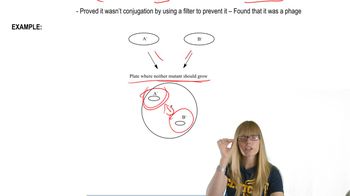True or False:Transduction uses viruses to transfer foreign DNA into bacteria
Table of contents
- 1. Introduction to Genetics51m
- 2. Mendel's Laws of Inheritance3h 37m
- 3. Extensions to Mendelian Inheritance2h 41m
- 4. Genetic Mapping and Linkage2h 28m
- 5. Genetics of Bacteria and Viruses1h 21m
- 6. Chromosomal Variation1h 48m
- 7. DNA and Chromosome Structure56m
- 8. DNA Replication1h 10m
- 9. Mitosis and Meiosis1h 34m
- 10. Transcription1h 0m
- 11. Translation58m
- 12. Gene Regulation in Prokaryotes1h 19m
- 13. Gene Regulation in Eukaryotes44m
- 14. Genetic Control of Development44m
- 15. Genomes and Genomics1h 50m
- 16. Transposable Elements47m
- 17. Mutation, Repair, and Recombination1h 6m
- 18. Molecular Genetic Tools19m
- 19. Cancer Genetics29m
- 20. Quantitative Genetics1h 26m
- 21. Population Genetics50m
- 22. Evolutionary Genetics29m
5. Genetics of Bacteria and Viruses
Transduction
Problem 9
Textbook Question
How is the frequency of cotransduction related to the relative positions of genes on a bacterial chromosome? Draw a map of three genes and describe the expected relationship of cotransduction frequencies to the map.
 Verified step by step guidance
Verified step by step guidance1
Understand the concept of cotransduction: Cotransduction refers to the simultaneous transfer of two or more genes from a donor bacterium to a recipient bacterium via a bacteriophage. This process occurs when the genes are close enough on the bacterial chromosome to be packaged into the same phage particle during transduction.
Explain the relationship between cotransduction frequency and gene distance: The frequency of cotransduction is inversely proportional to the distance between genes on the bacterial chromosome. Genes that are closer together are more likely to be cotransduced because they are more likely to fit within the same fragment of DNA packaged by the bacteriophage.
Draw a hypothetical gene map: Consider three genes (A, B, and C) on a bacterial chromosome. Assume the relative positions are as follows: A and B are close together, while C is farther away from both A and B. The map could be represented as: A---B----------------C, where the dashes represent relative distances.
Describe the expected cotransduction frequencies: Based on the map, the cotransduction frequency between A and B will be higher because they are closer together. The cotransduction frequency between A and C, as well as between B and C, will be lower because C is farther away from both A and B.
Summarize the relationship: The closer two genes are on the bacterial chromosome, the higher their cotransduction frequency. This relationship can be used to infer the relative positions of genes and construct genetic maps based on experimental cotransduction data.
 Verified video answer for a similar problem:
Verified video answer for a similar problem:This video solution was recommended by our tutors as helpful for the problem above
Video duration:
1mPlay a video:
Was this helpful?
Key Concepts
Here are the essential concepts you must grasp in order to answer the question correctly.
Cotransduction
Cotransduction is a genetic phenomenon where two or more genes are transferred together from one bacterium to another via a bacteriophage. The likelihood of cotransduction occurring is influenced by the physical proximity of the genes on the bacterial chromosome. Genes that are closer together are more likely to be packaged into the same viral particle, leading to higher cotransduction frequencies.
Recommended video:
Guided course

Transduction
Gene Mapping
Gene mapping involves determining the relative positions of genes on a chromosome. In bacteria, this is often done using cotransduction frequencies as a measure of distance between genes. By analyzing how often two genes are cotransduced, researchers can infer their relative locations, with closer genes showing higher cotransduction rates.
Recommended video:
Guided course

Mapping Genes
Bacterial Chromosome Structure
Bacterial chromosomes are typically circular and contain genes arranged in a linear order. The structure of the chromosome affects gene expression and the likelihood of genetic recombination events, such as cotransduction. Understanding the organization of genes on the chromosome is crucial for predicting the outcomes of genetic experiments and the relationships between gene positions.
Recommended video:
Guided course

Bacteria and Viral Chromosome Structure
Related Videos
Related Practice
Multiple Choice
502
views
1
rank


